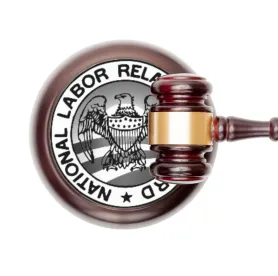In an Advice Memorandum released on May 25, 2022, NLRB General Counsel Jennifer Abruzzo laid out a blueprint for changes she’d like made to Board precedent concerning union representatives’ access to employer property. At issue is a pair of 2019 rulings by the NLRB in UPMC, 368 NLRB No. 2 (2019) and Kroger Ltd. P’ship, 368 NLRB No. 64 (2019), which together provided employers with greater latitude to bar union representatives from accessing public spaces within the employer’s facilities and grounds.
While an Advice Memorandum does not constitute a change in the law, it certainly gives a clear indication of how the current General Counsel will advise the Regions in deciding whether and how to prosecute future cases. This most recent GC memo makes good on initiatives she articulated last year (previously discussed here). The issue of union access to employer facilities was specifically foreshadowed as a topic for reassessment in the General Counsel’s “Mandatory Submissions to Advice GC Memorandum 21-04,” released on August 12, 2021.
Background – LT Transportation, Case 05-CA-281089
This Advice Memorandum is the result of an issue raised in a recent case before the Board, LAZ Parking Mid Atlantic, LLC, d/b/a LT Transporation, Case 05-CA-281089.
There, the conduct at issue was that the company wrote a letter to the union that was trying to organize the company’s drivers, prohibiting the union’s representatives from going to stops along the shuttle bus routes to talk to the drivers. The union argued that barring non-employee union agents from boarding the employer’s publicly-used shuttles violated Sections 8(a)(1) and (3) of the NLRA.
The union ultimately withdrew the charges after winning the election to represent the company’s shuttle bus drivers. However, the closing of the case allowed GC Abruzzo to issue the Advice Memorandum and opine on the legality of the prohibition of the union’s access to public facilities.
The History of Non-Employee Union Access Cases Pre-2019
In 1956, the Supreme Court issued NLRB v. Babcock & Wilcox Co., 351 U.S. 105 (1956), which held that employers could exclude non-employee union representatives from an employer’s property unless one of two conditions are present:
-
Employees are otherwise inaccessible to the union; or
-
The employer has discriminated against the union by prohibiting it from using the employer’s facilities, but provides access to non-union groups.
After Babcock, the Board was faced with a number of fact-specific scenarios confronting the discrimination questions, including situations involving “public spaces” – i.e., spaces either contained within, or adjacent to yet part of, an employer’s private property, but which were open to the public. The Board addressed whether an employer, by virtue of allowing the public to utilize a particular portion of its otherwise private property effectively discriminates when it excludes the union access to said property for purposes of engaging in otherwise protected, concerted activity.
Since Babcock, the Board held on numerous occasions that unions could access such public spaces, as long as organizers used them consistently with the public property’s intended use and were not disruptive to the employer. Cases over the years involved public sidewalks adjacent to a store, public restaurants located in a portion of the employer’s department store, public cafeterias, and casinos’ bars and restaurants.
The Board’s 2019 Decisions in UPMC and Kroger
In UPMC, 368 NLRB No. 2 (2019), the Board held that the “public spaces” exception referenced above was inconsistent with Babcock. In overruling the prior cases that outlined a “public spaces” exception, the Board announced that employers could eject union organizers or representatives from such “public spaces,” unless one of the two exceptions from Babcock were demonstrated: a showing of inaccessibility or discrimination based on the use by non-union groups.
The Board also took the opportunity to further define discrimination under the Babcock standard. The Board stated that discrimination in union access cases exists where “by rule or practice a property owner permits similar activity in similar relevant circumstances.” The focus, according to the Board, should be on the conduct of the non-employee organizers, rather than their identities.
In Kroger Ltd. P’ship, 368 NLRB No. 64 (2019), the Board found discrimination against non-employee organizers only where it can be found that other non-employees engage in “similar activity in similar relevant circumstances.” According to the Board, this standard encompasses both the literal activity engaged in, but also the purpose of the activity, which could result in an employer lawfully banning union organizers from distributing union literation, while allowing non-employee access for other charitable, civic and commercial activities.
General Counsel Abruzzo’s May 25th Advice Memo
General Counsel Abruzzo’s Advice Memorandum makes three principal points:
-
The Employer’s conduct in LT Transportation violated the NLRA, even based on the current standard. According to GC Abruzzo, the Employer’s prohibition was unlawful because it focused not on the union organizers’ conduct, but on their identity, as she believed the organizers did not engage in any activity – e., discussing working conditions with the drivers – in which the general public did not engage.
-
UPMC was incorrectly decided and should be overruled. According to GC Abruzzo, UPMC is inconsistent with Supreme Court precedent from Babcock and its progeny, which the Board was not privileged to alter. The Board, in UPMC, incorrectly likened the union organizers’ activities to salespeople surreptitiously entering the employer’s property, which according to GC Abruzzo, “disregards Section 1 and Section 7 of the Act.”
-
Kroger should also be overruled. The “similar in nature” standard illustrated by the Board in Kroger, according to GC Abruzzo, permits “[s]ingling out union activity for negative treatment,” and, therefore, is inconsistent with the NLRA.
Takeaways
Although the precedent in UPMC and Kroger remains good law for the moment, this Advice Memorandum clearly signals the General Counsel’s intention to encourage Regions to issue a complaint in similar subsequent cases, with the goal of getting the Board to ultimately overrule those decisions.
As a result, given the current composition of the Board for the foreseeable future, it seems all but inevitable that UPMC and Kroger will be overturned, and the “public spaces” exception under Babcock that existed prior to 2019 will go back into effect. If that occurs, then unions will (once again) be permitted to access public spaces on or adjacent to the employer’s private property, as long as the union representatives use the spaces consistently with the public property’s intended use and were not disruptive to the employer.





 />i
/>i
